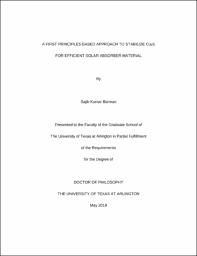
ATTENTION: The works hosted here are being migrated to a new repository that will consolidate resources, improve discoverability, and better show UTA's research impact on the global community. We will update authors as the migration progresses. Please see MavMatrix for more information.
Show simple item record
| dc.contributor.advisor | Huda, Muhammad N. | |
| dc.creator | Barman, Sajib Kumar | |
| dc.date.accessioned | 2020-06-23T22:06:25Z | |
| dc.date.available | 2020-06-23T22:06:25Z | |
| dc.date.created | 2019-05 | |
| dc.date.issued | 2019-05-14 | |
| dc.date.submitted | May 2019 | |
| dc.identifier.uri | http://hdl.handle.net/10106/29169 | |
| dc.description.abstract | Cu2S is an important low-cost, earth-abundant and non-toxic material which has shown its potential in the field of photovoltaics. Experimentally known band gaps of this material vary between 1.1-1.2 eV, which are suitable for applications in photovoltaics as solar light absorbers. Cu2S based thin film solar cells showed nearly 10% efficiency in the past. However, it exhibits complex phase behavior; Cu2S can be found in several different phases depending on its Cu-deficiency in the structures. In general, all the phases of this material suffer from spontaneous Cu-vacancy formations and Cu-diffusions in the crystal. The excessive or uncontrollable vacancy formation in the crystal structure makes the material to behave as a degenerate semiconductor. As a result, the performance of Cu2S based thin film solar cells deteriorates at ambient conditions over the time. To make efficient use of this material, reduction of Cu-vacancy formation and Cu-diffusion inside the crystal are the two most important challenges at the present.
Out of all the experimentally known phases, low chalcocite is the most stable stoichiometric phase at or below room temperature. Recently, density functional theory-based crystal database search has revealed a new stoichiometric phase, acanthite, which has higher thermodynamic stability in the ground state than the low chalcocite. In this work, we have found from room temperature molecular dynamics calculations, that these two have similar features in their crystal structures up to several nearest neighbor distances. Also, the electronic signatures of acanthite and low chalcocite Cu2S are comparable. Hence in this work we have argued that, instead of low chalcocite, the acanthite phase can be, in fact, used to model complex alloying of Cu2S since it has a simpler crystal structure and would serve for cost-effective computational studies.
We present density functional theory (DFT) based systematic studies on Ag and Sn doping in the both acanthite and low chalcocite phases of Cu2S. We show that Ag or Sn doping in Cu2S is thermodynamically favorable and can help to reduce the vacancy formation probability. The diffusion-energy barrier calculation reveals that an Ag atom doped at a Cu place can help to control Cu1+ ion diffusion inside the crystal. Ag:Cu2S band structures show that Ag doping increases the band gap by a favorable amount, which may help to maximize the photo-conversion efficiency. To further compensate the formation of Cu vacancies, we looked for another alloying element. After a several elemental-searches by DFT calculations, we have decided on Sn. For Sn doped Cu2S, we show that Sn introduces defect states at or near the Fermi level in band structures. However, such Sn doping effects can be compensated with suitable Cu-vacancies in the crystal. Finally, from the chemical potential landscape analyses, the results reported here show that the Cu2S can be stabilized with Ag or Sn doping. | |
| dc.format.mimetype | application/pdf | |
| dc.language.iso | en_US | |
| dc.subject | Cu2S, Crystal phase stability, DFT, Electronic structures, Thermodynamics, Defect studies, Cu vacancy and diffusion, Ag doping, Sn doping | |
| dc.title | A FIRST PRINCIPLES BASED APPROACH TO STABILIZE Cu2S FOR EFFICIENT SOLAR ABSORBER MATERIAL | |
| dc.type | Thesis | |
| dc.contributor.committeeMember | Atta-Fynn, Raymond | |
| dc.degree.department | Physics | |
| dc.degree.name | Doctor of Philosophy in Physics and Applied Physics | |
| dc.date.updated | 2020-06-23T22:06:26Z | |
| thesis.degree.department | Physics | |
| thesis.degree.grantor | The University of Texas at Arlington | |
| thesis.degree.level | Doctoral | |
| thesis.degree.name | Doctor of Philosophy in Physics and Applied Physics | |
| dc.type.material | text | |
| dc.creator.orcid | 0000-0003-4129-7202 | |
Files in this item
- Name:
- BARMAN-DISSERTATION-2019.pdf
- Size:
- 3.384Mb
- Format:
- PDF
This item appears in the following Collection(s)
Show simple item record


